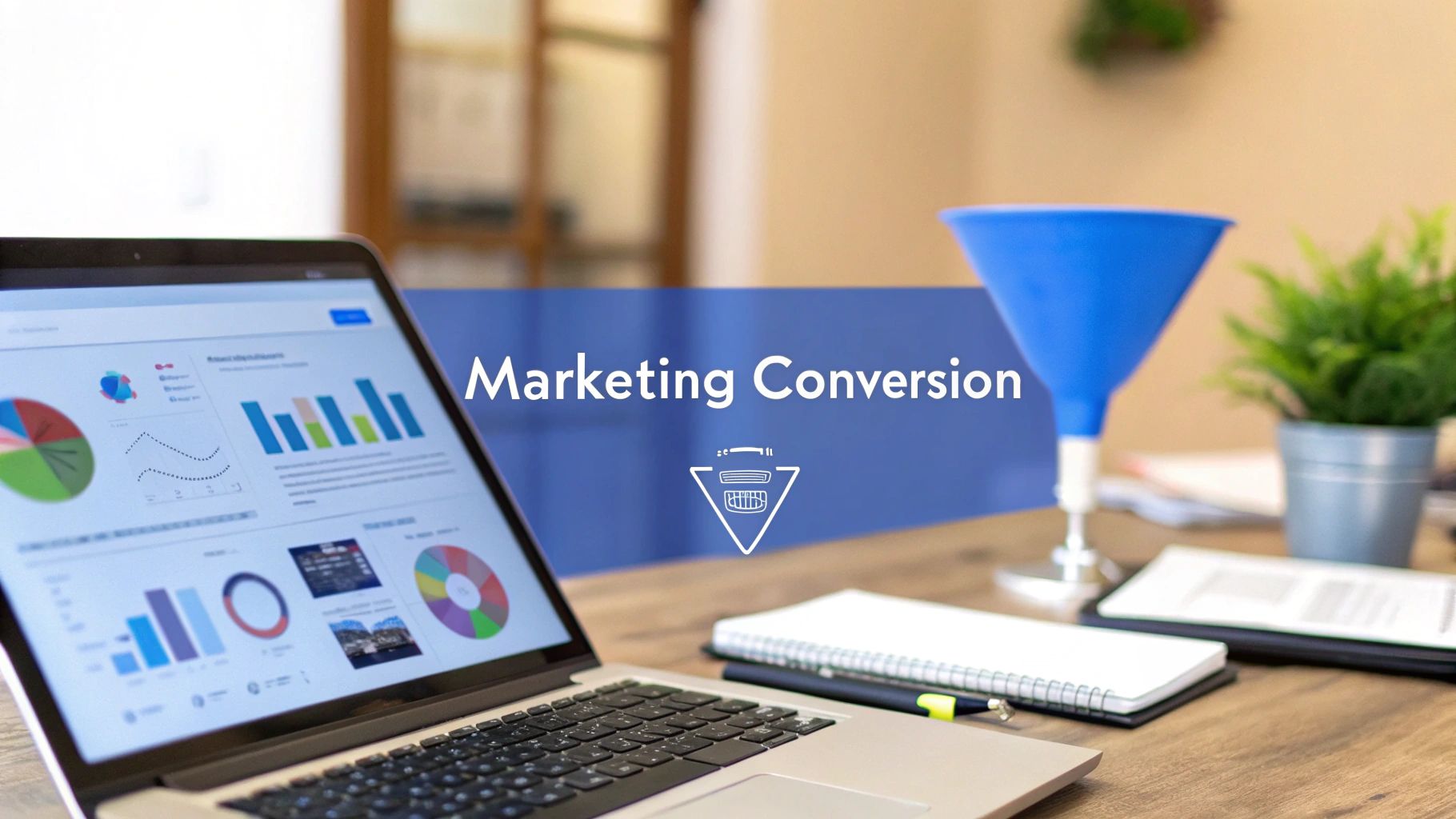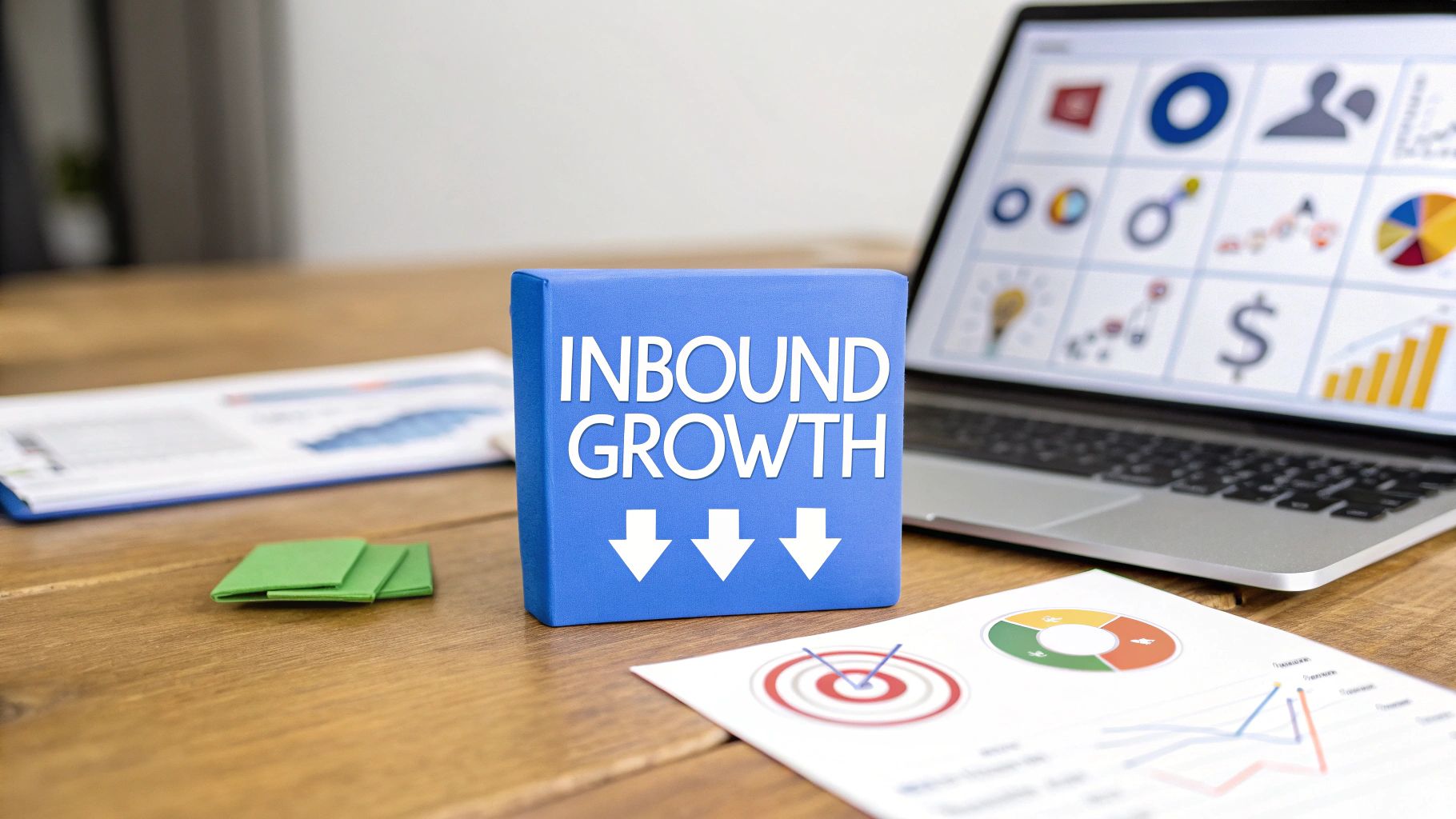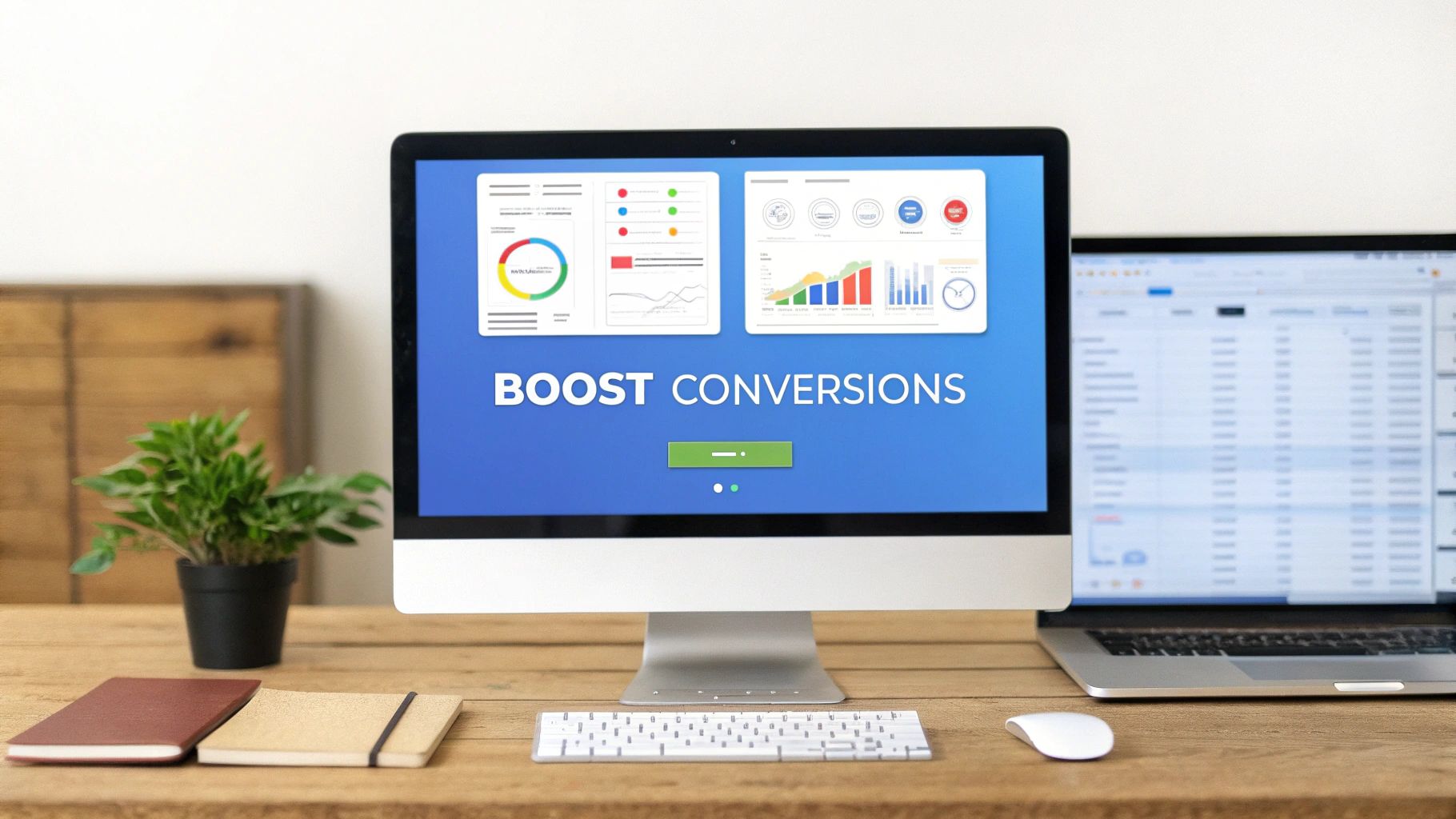Summary
Meta Description: Discover what conversion in marketing really means. Learn to track, calculate, and boost the actions that drive real business growth, from clicks to customers.
In the world of marketing, a conversion is the magic moment when a website visitor takes the exact action you want them to. It's the pivotal point where a casual browser stops just looking and takes a specific, desired action, signaling a huge leap forward in their journey with your brand.
This action could be anything. Did they buy a product? Did they sign up for your email list? That's a conversion.
Understanding Your Marketing Finish Line

Think of your marketing efforts as building a path for potential customers. A conversion is the destination—it's your marketing finish line. More importantly, it’s the concrete result proving your strategy is connecting with people.
Let’s use a simple analogy. Imagine someone walks into a coffee shop. They might browse the menu, enjoy the aroma, and watch others. These are just interactions. The conversion only happens when they walk up to the counter and say, "One latte, please." That’s the commitment.
From Interest to Action: What Defines a Conversion Goal?
Online, the same principle applies. Without conversions, all you have is website traffic—a crowd of window shoppers. Measuring conversions is how you separate people with passive interest from those with genuine intent.
So, what are the most common conversion goals marketers track?
- Making a purchase: The ultimate goal for any e-commerce site.
- Submitting a form: This could be a contact form, a quote request, or a demo signup.
- Subscribing to a newsletter: A fantastic way to build your email list for future campaigns.
- Downloading a resource: Offering a valuable guide in exchange for contact info.
A conversion isn't just a click; it's a clear signal that your message resonated enough for your audience to take the next step. It’s the ultimate measure of marketing effectiveness.
To truly master this, a great starting point is understanding what a conversion funnel is and how it maps the customer journey. Each conversion acts as a vital key performance indicator, so it’s also crucial to learn how to choose the right KPI for a website to accurately measure what matters.
Why Do Conversions Drive Business Growth?
Knowing what a conversion is is just step one. The real magic happens when you grasp why this single metric is the engine for sustainable business growth. Without it, you’re essentially just spending money on marketing and hoping something sticks.
Conversions are the clearest signal of your marketing return on investment (ROI). They cut through the noise and tell you exactly which campaigns are hitting the mark. Think of it this way: website traffic is potential, but conversions are profit.
From Data Points to Strategic Decisions
When you analyze conversion data, it's like putting on a new pair of glasses. You can see right into your customer's behavior—where they get stuck, what messages make them click, and which channels deliver your best customers. This isn't about chasing vanity metrics; it’s about making smart, data-backed decisions that grow your bottom line.
By focusing on the actions that truly matter, you can:
- Optimize Your Marketing Budget: Funnel cash away from underperforming campaigns and into the ones that actually work.
- Refine Your Customer Journey: Find and eliminate those friction points on your website that cause potential customers to leave.
- Improve Your Products and Services: Get a real feel for what features your audience actually cares about.
This diagram breaks down how focusing on your conversion rate, ROI, and smoothing out friction in your funnel all work together to fuel growth.
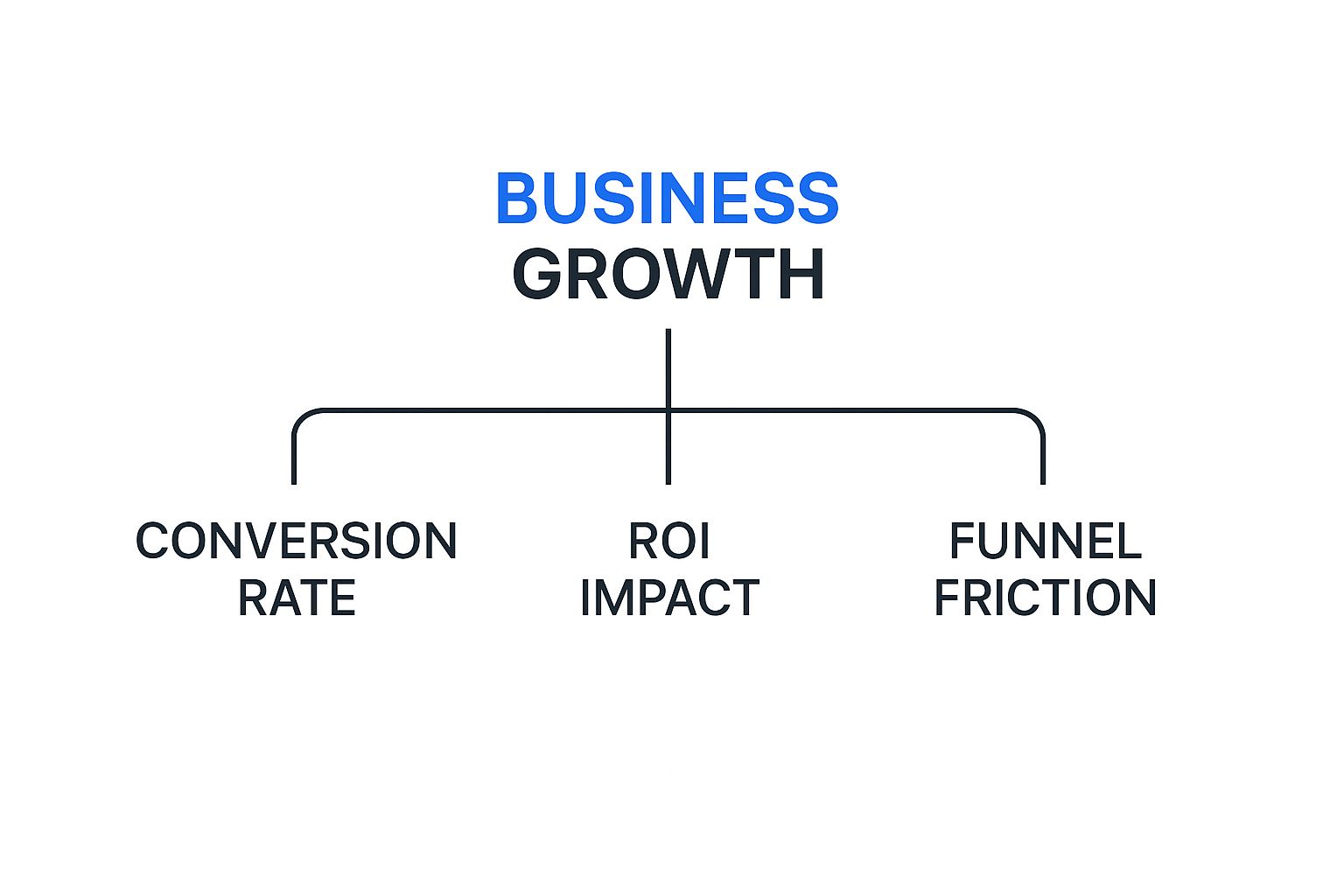
As you can see, growth isn't just about cramming more people into the top of your funnel. It's about getting better at turning the traffic you already have into customers.
In short, every conversion validates your strategy. It’s proof that you’re not just reaching people—you’re persuading them to take a meaningful step.
Decoding Different Types of Conversions
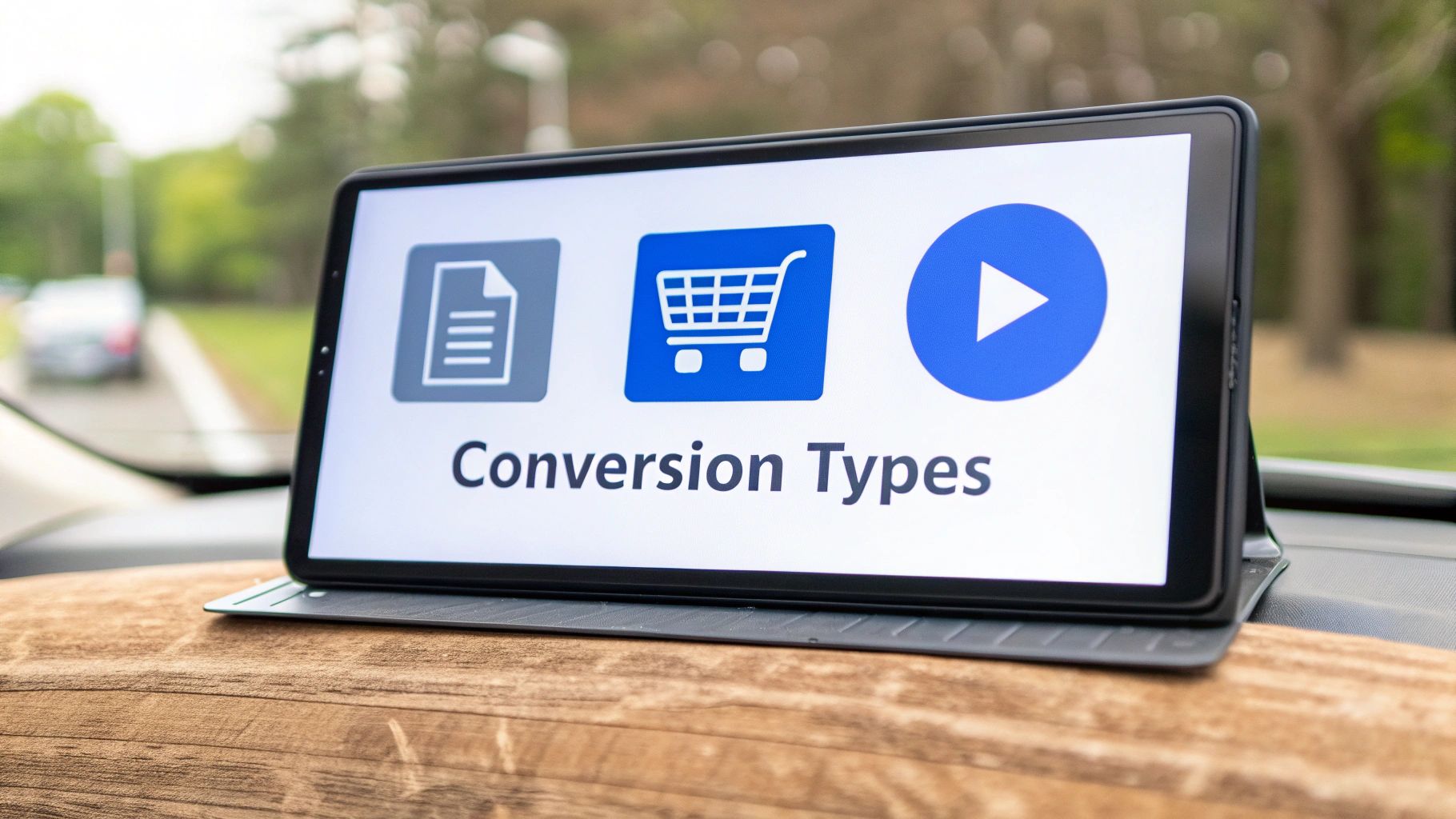
Let's get one thing straight: not all conversions are created equal. Think of it like a road trip. You have your final destination, but you also have cool little stops along the way that make the journey worthwhile.
In marketing, these are macro-conversions and micro-conversions. Nailing the difference is how you see the entire story of your customer's experience, not just the final chapter.
A macro-conversion is the big one—the primary action you want a user to take. This is the stuff that directly impacts your bottom line.
Then you have micro-conversions. These are the smaller, but still vital, steps a user takes on their way to that main goal. They show someone is interested and moving in the right direction.
Primary Goals vs. Supporting Actions: An In-Depth Look
Looking at your performance through both of these lenses tells a much richer story. Someone might not be ready to buy today (the macro-conversion), but they might sign up for your email list (a micro-conversion). That small action is huge—it keeps them in your world so you can nurture that relationship.
Let’s break it down with some examples:
- For an e-commerce store: The macro-conversion is a completed purchase. Micro-conversions would be adding a product to the cart or creating an account.
- For a SaaS company: The macro is a paid subscription. The micros leading up to it could be watching a demo video or starting a free trial.
- For a service-based business: The ultimate macro is a signed client contract. Micro-conversions are actions like filling out a contact form or booking a free consultation.
Tracking only macro-conversions is like watching only the last two minutes of a championship game. You see who won, but you miss all the brilliant plays and turning points that decided the outcome.
To help you map this out for your own business, here’s a quick breakdown of common macro and micro goals.
Macro vs. Micro Conversions Across Business Models
This table illustrates common macro (primary) and micro (secondary) conversion goals for different types of online businesses, helping you identify what to track.
This table should give you a solid starting point for defining what success looks like at every stage.
It's also critical to remember that "good" conversion rates vary widely by industry. For example, e-commerce conversion rates can swing from a modest 1.9% in fashion to a healthy 6.8% for personal care products. Context is key. You can find more e-commerce benchmarks by industry here.
By tracking both types of conversions, you can spot the weak links in your funnel and optimize every step of the path to purchase.
How to Calculate Your Marketing Conversion Rate
Okay, so you know what you should be tracking. Now it’s time to measure what matters.
Calculating your conversion rate might sound technical, but it’s surprisingly straightforward. It's the single most important number for figuring out if your marketing is actually working. It tells you exactly what percentage of visitors are doing what you want them to do.
The formula is simple:
(Total Number of Conversions / Total Number of Visitors) x 100 = Conversion Rate (%)
Let's put that into perspective. Say your landing page got 2,000 visitors last month, and 50 of them signed up for your newsletter. Pop those numbers into the formula, and you get a conversion rate of 2.5%. It's that easy.
This simple calculation is the bedrock of performance tracking. For a deeper look, check out our guide on how to calculate cost per acquisition to see how these numbers work together.
Why Context Is Everything in Conversion Data
So, is a 2.5% conversion rate good? The only honest answer is: it depends. That number could be amazing for one business but a disaster for another. Why? Because context is everything.
Several factors will change what a "good" rate looks like for you:
- The specific goal: Asking for a purchase is a huge commitment, so you’d expect a lower conversion rate. A free newsletter signup? That’s a smaller ask, so the rate should be higher.
- Industry benchmarks: E-commerce, SaaS, and lead generation all have wildly different average conversion rates.
- Traffic source: Someone who types your URL directly is far more likely to convert than someone who stumbled across a social media ad.
For example, direct traffic often converts at around 3.3% because those visitors already know your brand. Paid search ads average closer to 3.2%. Are your rates in the right ballpark?
Understanding these nuances helps you set realistic benchmarks. Discover more insights about conversion statistics on bloggingwizard.com.
Proven Strategies to Boost Your Conversions
Knowing your conversion rate is the first step, but improving it is how you win. That’s where Conversion Rate Optimization (CRO) comes in. Think of it as part art, part science—all focused on turning more visitors into customers.
It’s all about making the path from A to B as smooth and irresistible as possible. The foundation of any good CRO strategy is a solid user experience (UX). If your site is slow or confusing, people will leave. Your mission is to eliminate every bit of friction standing in their way.
Craft Compelling Calls to Action
One of the quickest wins in CRO often comes from your call-to-action (CTA). A generic CTA like "Submit" isn't going to inspire anyone. You need action-packed language that clearly spells out the value for the user. What will they get?
Try these tips for instantly better CTAs:
- Be Specific: Instead of "Download," try "Get Your Free Ebook Now."
- Create Urgency: Simple phrases like "Limited Time Offer" nudge people to act now.
- Use Contrasting Colors: Your CTA button should jump off the page. Make it impossible to miss.
The single best way to know what works is to test it. A/B testing, where you compare two versions of a page to see which performs better, removes the guesswork from optimization.
Understanding your key metrics is also fundamental. For example, the average sales call conversion rate is between 13% and 25%. But referrals convert at a whopping 25.56%. This data tells you exactly which channels send your most motivated prospects.
Building trust is another huge piece of the puzzle. Show off social proof like customer testimonials, reviews, and case studies. When new visitors see that others have had a great experience, they feel much more confident taking that next step.
If you want to go deeper, check out our guide on conversion rate optimization best practices.
Ready to put all this into practice? Explore these proven tips to improve website conversion rates.
Common Questions About Marketing Conversions
As you start to grasp marketing conversions, a few questions always pop up. Let's tackle them head-on so you can move from theory to action.
One of the first things everyone wants to know is, "What's a good conversion rate?" Honestly, it's all over the map. You might see a general e-commerce average floating around 2-3%, but a “good” rate is completely relative. It boils down to your industry, your traffic source, and the specific goal you're measuring.
Leads vs. Conversions: What Is the Difference?
It’s also super important to get the distinction between a lead and a conversion straight.
Think of a lead as the first handshake—someone shows interest by downloading your ebook or filling out a contact form. A conversion, on the other hand, is the final, desired action you were aiming for, like that same person eventually buying your product.
A lead is a critical step in the journey, often a micro-conversion, but it's the final macro-conversion that really hits your bottom line.
What Are the Essential Tools for Tracking Conversions?
So, how do you keep track of all this without getting lost? You don’t need a massive, complicated tech stack. A handful of essential tools will give you the data you need to make smart moves.
- Google Analytics: This is your non-negotiable starting point. It's the best way to see how people behave on your site, set up goals, and see which channels bring in conversions.
- Customer Relationship Management (CRM) Platforms: Tools like HubSpot or Salesforce are perfect for tracking leads as they move through your pipeline, connecting marketing efforts to actual sales.
- Heatmap & A/B Testing Tools: Want to see what users really do? Platforms like Hotjar or VWO show you where people click and scroll, and let you test different page versions to see what works best.
When you use these tools together, you get the full story. It’s how you turn abstract numbers into real, actionable insights that help you grow.
Ready to turn more clicks into customers? LanderMagic creates dynamic, high-converting landing pages tailored to every ad click, ensuring your post-click experience is just as powerful as your ad. Start optimizing your campaigns and see real results today at https://landermagic.com.



